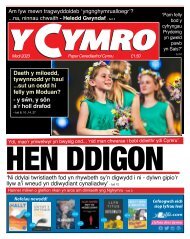Create successful ePaper yourself
Turn your PDF publications into a flip-book with our unique Google optimized e-Paper software.
46<br />
LUCENT DREAMING<br />
the first paragraph. Though we read completely through every submission we get<br />
to give feedback, we know many slush readers don’t.<br />
The key to a good opening is to start where the story starts. Most of the<br />
time in a first draft we writers have to warm up a bit to the story and work our<br />
way into it slowly. This can leave us with a lot of fluff in the beginning that isn’t<br />
exactly exciting to read. This is normal, we just need to remember to shave off<br />
that false start.<br />
Take for example the short story Jonas recently wrote for <strong>Lucent</strong> <strong>Dreaming</strong>’s<br />
sample issue. Here’s his original opening:<br />
Pink light drained from the sky, falling behind the horizon to leave only cool, royal waters and a<br />
pearlescent moon overhead. Thom sat on his deck overlooking the yard as the light dimmed and the<br />
air became chill in his nostrils. He leaned his elbows on the railing and lit a cigarette. The crickets<br />
sang in the summer night, and stars slowly began to wink above. Thom tapped a finger against one<br />
leg of the tripod that held his telescope—a gift from Andreus—and watched passing headlights on<br />
the road. Soon a pair of lights would stop, blink off, and he’d hear a car door slam and feet padding<br />
on the stone slab walkway through the grass.<br />
There’s a lot of description in there. It paints a nice picture, but nothing is<br />
happening. Jonas was setting the scene, getting into the mood of the story, but<br />
when he went back he saw that it’s not really important to the story (especially<br />
for a short story where there are word limits).<br />
CUT TO THE ACTION What’s the first thing that happens? He leans his elbows<br />
on the railing. Okay, so we can cut everything before that. But, can we go further?<br />
Do we really need that description of the night and the cigarette which have<br />
nothing to do with the story? The telescope plays a major part in the story so<br />
that makes it the first story related thing we see. Based on that, this is what<br />
Jonas came up with on his next draft:<br />
Thom tapped a finger against one leg of the tripod that held his telescope—a gift from Andreus—and<br />
watched passing headlights on the road. Soon a pair of lights would stop, blink off, and he’d hear<br />
a car door slam and feet padding on the stone slab walkway through his neatly trimmed grass.<br />
That is already easier to read because we start with something happening.<br />
Sometimes it can take a discerning eye and a lot of experience to spot the first<br />
important thing that happens, but once you’ve found it, often you can simply<br />
delete everything before that point. But remember to save your deletions in<br />
another document!<br />
Of course, there are many ways to start a story. The key is to be engaging.<br />
You can think of it this way, too: What is the first thing that absolutely can’t be<br />
cut from the story? Once you find out what that is, it might be a good idea to<br />
start there.<br />
by Jonas David and Jess Beynon

















